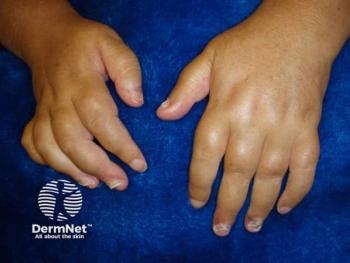
Caring for the diabetic foot
Patients with psoriasis have a higher risk of developing new onset diabetes mellitus. It’s a risk that’s been described as statistically significant. So, in this article, we examine dermatologic care for diabetic foot infections.
Patients with psoriasis have a higher risk of developing new onset diabetes mellitus. The increased incidence of psoriasis and diabetes mellitus was documented in a 2013 study by Usman Khalid, et al. published in Diabetes Care in which authors described the correlation as “statistically significant.” So, in this article, we examine dermatologic care for diabetic foot infections.
Dermatologists must be able to diagnose and manage mild-to-moderate infections in diabetic foot ulcers (DFUs), said Warren S. Joseph, D.P.M., FIDSA, in a presentation at DERMfoot 2018 in Baltimore.
Dr. Joseph, who is a consultant at Roxborough Memorial Hospital in Philadelphia where he specializes in lower extremity infectious diseases, is an author of the 2012 Infectious Diseases Society of America (IDSA) treatment guidelines.
Dermatologists must be able to distinguish between noninfected diabetic foot infections and those that are mildly or moderately infected, he said. "We differentiate the infected from the noninfected by looking for the clinical signs and symptoms of infection – erythema, heat, swelling and induration." Patients must possess at least two of these criteria, which also include local tenderness or pain and prurulence. Mild infections affect only the skin and subcutaneous tissues, while moderate infections include deeper tissues or erythema greater than two cm, but no signs of systemic inflammation.
"All mild and most moderate diabetic foot infections can be treated on an outpatient basis," he said. A publication he co-authored applies the IDSA classification scheme to all skin and soft tissue infections (SSTIs). Published in Open Forum Infectious Diseases in January 2017, this article suggests hospitalization and consideration of cultures and surgery for more severe types of moderate SSTIs.
The IDSA requirement to classify diabetic foot infections as infected or noninfected is a key take-home message, he said, because it drives treatment decisions. "For years, people would say, 'These patients don't respond to infection, and therefore they may not demonstrate the classic signs of inflammation. What about subclinical infection that keeps wounds from healing?' But I don't believe there's particularly good evidence behind this concern."
IDSA guidelines also advise against culturing noninfected wounds or treating them with antibiotics. "If you take a culture of a clinically noninfected wound, you're going to grow all sorts of bacteria. And none of them are necessarily causing infection."
According to IDSA guidelines, many of diabetic foot infections can be treated in the outpatient setting. Guideline authors write, "Clinicians can probably use highly bioavailable oral antibiotics alone in most mild, and in many moderate, infections and topical therapy for selected mild superficial infections (strong recommendation, based on moderate evidence)." With modern antibiotics that are more clinically bioavailable, or bioequivalent to IV antibiotics, said Dr. Joseph, "It doesn't matter whether they're given IV or PO. You've really got the same tissue levels. So there's no reason to hospitalize patients unless they are septic or medically unstable. That's not the patient that the average dermatologist deals with."
Currently, said Dr. Joseph, only three antibiotics have FDA approval for diabetic foot infections. Ertapenem, piperacillin/tazobactam and linezolid (the only oral option) had been approved for these indications, he said, until the FDA removed diabetic foot infections from its acute bacterial skin and skin structure infection clinical-trial guidelines in 2013. Nevertheless, said Dr. Joseph, dermatologists can use any antibiotics off-label if they will be effective against the bacteria present.
A pooled retrospective analysis of two phase three trials involving acute bacterial skin and skin structure infection showed no difference in efficacy in the use of linezolid and tedizolid whether the infection was in the lower extremity versus other parts of the body, said Dr. Joseph, lead author of the analysis. This publication appeared in the July 2017 edition of the Journal of the American Podiatric Association.
Regarding duration of therapy, "We must move beyond the concept of giving an automatic number of days of antibiotic therapy. You can't assume that 10 days, or two weeks, is the right number. What happens if the infection looks better in four days? Then you're giving 10 more days of antibiotics which the patient probably doesn't need."
Instead, he suggested basing duration of therapy on clinical response. "Not long ago, the concept of 'better plus two' was floated. I believe it's very valid – treat patients until they are clinically better, plus two more days before discontinuing the antibiotic. The big thrust nowadays in the pharmacy and infectious disease worlds is antimicrobial stewardship – using the narrowest-spectrum antibiotics for the shortest period of time to avoid developing antimicrobial resistance."
Regarding methicillin-resistant Staphylococcus aureus (MRSA), IDSA guidelines recommend considering initial empirical therapy in three clinical situations:
• If the patient has a previous history of MRSA.
• If local MRSA prevalence is high. "We left that intentionally vague. But if it's more likely MRSA than not, it's worth using empirical MRSA therapy until proven otherwise," said Dr. Joseph.
• For severe infections where one cannot afford to be wrong.
"I'll add one more," said Dr. Joseph. "IDSA guidelines differentiate prurulent from non-prurulent cellulitis. In other words, if the patient has pus, one must consider MRSA until proven otherwise. We know MRSA produces more pus than methicillin-susceptible Staph aureus does." For mild to moderate infections in patients who have not recently received antibiotic treatment, IDSA guidelines suggest that therapy targeting only aerobic gram-positive cocci may suffice.
Many physicians are concerned about Pseudomonas, added Dr. Joseph. "But Pseudomonas is very rarely a pathogen in diabetic foot infections. It is found less than 10 percent of the time because it's a colonizer – you just find it on wounds. That's the same even with venous stasis ulcers." But as with predetermined durations of antibiotic therapy, "We've got to get away from assuming that Pseudomonas is actually a pathogen in these wounds – at least in the United States, Canada and Western Europe." Pseudomonas is much more prevalent in hot, humid climates such as those of the Southern Hemisphere, the Indian Subcontinent and the Far East, he said.
Finally, Dr. Joseph recommended the IDSA webpage (www.idsociety.org) as an indispensable resource for treating diabetic foot infections and SSTIs, including those involving MRSA.
DISCLOSURES
Dr. Joseph is a speaker for Merck, maker of tedizolid.
REFERENCE
Joseph WS, DPM. "Practice Guidelines for the Management of Diabetic Foot Infections," DERMfoot 2018. April 15, 2018.
Newsletter
Like what you’re reading? Subscribe to Dermatology Times for weekly updates on therapies, innovations, and real-world practice tips.


















